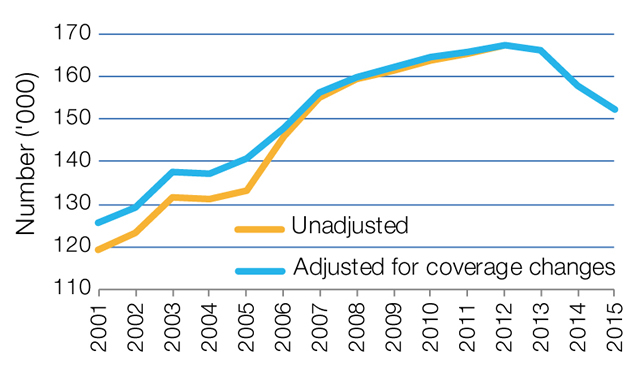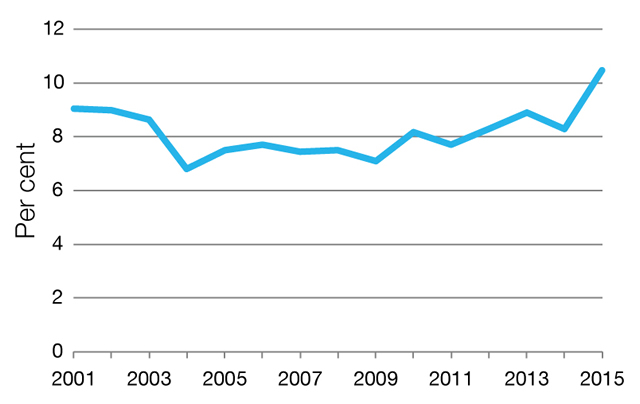Philip Hamilton, Politics
and Public Administration
Key issues
Enterprise bargaining continues.
The Australian Public Service (APS) Commissioner has outlined future directions for the APS.
The Department of Finance is developing a new Commonwealth Performance Framework.
Recommendations of the review of internal red tape are being implemented.
A government transformation agenda has been announced, but with few details at this stage. ICT projects are likely to have a prominent role.
APS workforce
Workforce size
Data produced by the Organisation for Economic
Co-operation and Development (OECD) indicates that for 2000, 2008 and 2013, employment
in the Australian public sector was around 15 per cent of the total labour force (including federal,
state and local levels). In 2013, the OECD average was 19.3 per cent.
The Australian
Public Service Commission (APSC) has reported that at 30 June 2015
there were 152,430 staff employed under the Public Service Act
1999—down 5,526 (or 3.5 per cent) from 157,956 in June 2014.
Figure 1 shows the change in total APS employee numbers over the past 15 years.
Figure 1: APS employee numbers, 2001–2015

Source: Australian Public Service Commission
(APSC), Australian
Public Service Statistical Bulletin 2014–15, APSC, Canberra, 2015.
The adjusted line takes account of coverage
changes in the APS each year, by adjusting total APS employee numbers by
the number of employees performing functions moving into or out of coverage of
the Public Service Act 1999.
APS Commissioner John Lloyd PSM has observed
that ‘over the past 10 years the number of non-ongoing employees in the
APS has steadily increased. This is a healthy sign and reflects the changing
nature of public sector work’. Figure 2 shows non-ongoing APS employees as a
percentage of total APS employees from 2001 to 2015, including an apparent
longer-term trend since 2010 and a more pronounced increase since 2014.
Figure 2:
Percentage of non-ongoing APS employees in the APS, 2001–2015

Source: APSC, Australian
Public Service Statistical Bulletin 2014–15, APSC, Canberra, 2015.
Enterprise agreements
The salaries of most public servants are determined
in agency enterprise agreements, the majority of which expired on 30 June 2014.
Negotiations towards new agreements have been protracted, most recently because
the caretaker
conventions effectively precluded significant steps in the bargaining process
during the two-month election period.
A substantive point of contention is the position outlined
by the APS Commissioner: ‘Government policy for the current bargaining round is
to remove the more detailed policy and process content from enterprise
agreements, and place this material in agency documentation.’ The Community and Public
Sector Union considers that the use of agency policy documents rather than
agreements would reduce employees’ access to dispute resolution procedures in some
circumstances.
Future directions
In March 2016 the APS Commissioner outlined the
future direction of the APS. Priorities include:
- more effectively using employment types such as part-time, casual,
fixed-term, contractor and labour-hire
- reducing complexity and timeframes in recruitment
- facilitating mobility of staff between agencies, and between the APS
and the private sector
- using talent management to identify high potential people and
preparing them for business-critical roles
- improving performance management
- reducing the complexity and length of separation processes and
- moving HR management beyond a focus on transactions and toward
planning and strategy.
Budgeting for the APS
Program funds and running
costs
Most Budget appropriations for public service
agencies are classified as either administered
or departmental.
Administered funds are
administered by an agency on behalf of the government for the benefit of
parties who are external to the agency, generally through programs. For
example, the Department of Human Services (DHS) provides income support
payments. Agencies have no discretion in how administered funds are spent. For
example, DHS must make income support payments to applicants who fulfil eligibility
requirements. Other examples of administered program funds include grants,
subsidies, and other obligations arising from legislated eligibility rules and
conditions.
In contrast, departmental funds are generally
intended to cover agency running costs such as employee salaries and the purchase
or rental of equipment and property.
In 2014, the National Commission of Audit reported
that ‘of total Commonwealth spending in 2013‒14, some $360 billion
(or 88 per cent) comprised administered expenses with less than $50 billion
(or 12 per cent) categorised as departmental expenses’. As such, even
significant cuts to departmental expenses have only a minor impact on total
government expenditure.
Efficiency dividend
In place for over 25 years, the efficiency
dividend (ED) is an annual funding reduction for Australian government
agencies, in general applied only to departmental expenses. The ED has ranged
from 1 to 4 per cent over its life. The 2016–17
Budget provided that the ED will be maintained at 2.5 per cent
through 2016–18, before being reduced to 2 per cent in 2018–19 and
1.5 per cent in 2019–20.
In a first for the ED, the 2016–17 Budget indicated
that public sector agencies can anticipate the re-investment of a portion of
projected ED savings ($500.0 million) for ‘specific
initiatives to assist agencies to manage their transformation to a more modern
public sector’. This will mean a total estimated net ED saving of
$1.4 billion over 2017–20.
Managing the APS
Planning and reporting
The Department of Finance is leading a Public Management Reform
Agenda which, through a new Commonwealth Performance Framework
(CPF), will result in significant changes to Commonwealth
entities’ planning and reporting. In
the 44th Parliament, the Joint Committee of Public Accounts and Audit
(JCPAA) produced two reports on the CPF, the second of which recommended that Finance should produce an
incoming brief about the CPF for the JCPAA of the 45th Parliament.
Reducing red tape
The 2015 report of the Independent Review of
Whole-of-Government Internal Regulation (the Belcher Red Tape
review) made 134 recommendations, most of which can be implemented
administratively within the public service. However, full implementation of
some recommendations will require consideration by parliamentary
committees, the Senate or legislative
amendments.
Outsourcing
Notable agency-specific outsourcing projects in
progress include:
In a project
likely to be of relevance to all agencies, in early 2016 the Department of
Finance sought
‘the views of interested parties on the most effective and efficient way to
consolidate shared and common service delivery’, in particular ‘whether
opportunities may exist for partnering with the private sector to deliver
shared services’. The first tranche of shared services will focus on ‘core
transactional services’ considered
to be low risk, low to moderate complexity, and high volume of activity.
Examples include accounts payable/receivable and payroll administration.
ICT projects
During the 2013 election campaign, the Coalition undertook to‘improve the transparency of government ICT spending with the
establishment of a US-style online
dashboard so taxpayers can assess the performance and progress of major
projects’.
In the 2016 election campaign the Coalition
promised an expanded online dashboard enabling ‘public dashboard users ... to track the
performance of key government services, including: cost per transaction, user
satisfaction, and completion rates’. A performance dashboard of
this type is being developed by the Digital Transformation Office. A US-style projects/spending dashboard is yet to be
released, although an ICT dashboard is mentioned on the Department
of Finance website in the context of government investment in ICT.
The number of projects that would feature in a projects/spending
dashboard is likely to increase. One stated theme of the 2016‒17 Budget was transforming Government, including
by ‘maximising the opportunities of a digital dividend wherever possible’.
The ICT capability of Medicare received some
exposure in the 2016 election campaign, albeit in the context of a
highly-charged debate over the possible privatisation of Medicare.
In August 2014 the Government sought
‘Expressions of Interest from the private sector’ for handling the claim and
payment functions of both Medicare and the Pharmaceutical Benefits Scheme.
However, during the campaign the Prime Minister gave a commitment
that ‘every aspect of Medicare that is delivered by Government today will
continue to be delivered by Government in the future, full stop’. While that
statement aimed to address the privatisation issue, there appears to be a
broadly-held view that Medicare’s ICT capability still requires attention:
- During the election campaign, the Opposition health spokesperson stated
that ‘the IT system is going to have to be modernised at some point’, and it
was reported
that in 2009 the then Labor Government had sought to improve Medicare’s systems
in collaboration with the private sector.
- The incoming
president of the Australian Medical Association has described
Medicare’s ICT as ‘clunky, 30 years old’ and ‘not fit for purpose’.
- The Chief Information Officer of the Department of Human Services
has been quoted
as suggesting the Medicare system needs to be addressed within a four-year
period.
One industry analyst has observed
that a challenge will be bringing in sufficient external expertise without
compromising on ownership of the final delivered systems, as ‘the worst answer
would be for the pendulum to swing all the way back in the other direction and
for the government to start coding a whole new Medicare system from scratch’.
Further reading
P Hamilton, ‘Reducing Red Tape in the public service 1: committees and the Senate’, FlagPost, Parliamentary Library blog, 21 December 2015.
P Hamilton, ‘Reducing Red Tape in the public service 2: legislation’, FlagPost, Parliamentary Library blog, 21 December 2015.
P Hamilton, ‘
Selected government ICT projects’,
Budget Review 2016–17, Parliamentary Library, Canberra, May 2016.
Back to Parliamentary Library Briefing Book
For copyright reasons some linked items are only available to members of Parliament.
© Commonwealth of Australia

Creative Commons
With the exception of the Commonwealth Coat of Arms, and to the extent that copyright subsists in a third party, this publication, its logo and front page design are licensed under a Creative Commons Attribution-NonCommercial-NoDerivs 3.0 Australia licence.